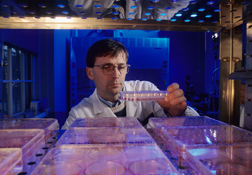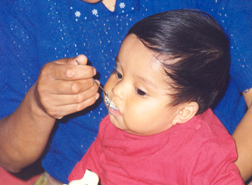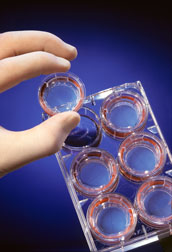Boosting Iron Absorption in Infants
A focus on food combos and the size of meat particles in them.
Porridge recipes devised with the help of impoverished mothers in Peru. Taste tests involving infants. The size of meat particles in foods. An innovative in vitro model that mimics digestive processes.
All these were critical elements in a 3-year ARS study with Cornell University aimed at boosting the amount of iron that infants in developing countries absorb from their meals.
Raymond Glahn, a physiologist at ARS’s U.S. Plant, Soil, and Nutrition Research Unit in Ithaca, New York, says the study—parts of which were conducted in Ithaca and in Peru—investigated some critical social aspects that hinder iron intake in these infants. “Among these was the nutritional quality of the complementary foods, such as cereal, that supplement breast milk and are essentially the first solid foods that infants consume,” he says.
Also examined in this work—which was funded by ARS, the National Institutes of Health, and Kraft Foods—were such factors as the palatability and social acceptance of dishes that may offer infants more bioavailable iron.
Bioavailability is the degree to which a substance is absorbed into a living system.
“Assuring sufficient bioavailable iron in these foods is important because children who are 5 to 6 months old are at a critical stage,” says Glahn. “This is a phase at which iron stores from birth are becoming depleted. The infants are growing rapidly at this time, and one of their major requirements is iron.”
In Ithaca, Glahn and Cornell-affiliated colleagues Helena Pachón and Rebecca Stoltzfus used the in vitro digestive model to identify food combinations that may best promote iron uptake in infants.
|
|
The Smaller the Better?
The researchers also came across an important finding regarding the size of meat particles in processed foods. “We observed that small pieces of meat in the porridges we developed yielded more bioavailable iron than larger pieces,” says Glahn.
According to results obtained using the digestion model, homogenizing and freeze-drying beef and chicken increases the iron-absorption boost that cereals get when supplemented with those meats. The homogenization process reduces the meat to small, uniform particles that can be distributed evenly throughout a liquid.
Among the group’s objectives was to confirm recent Swedish studies suggesting that food-particle size is a factor in iron absorption.
“A key factor in our work was the amount of time that the cooked and freeze-dried meats were processed,” says Glahn. “The in vitro evaluation showed that iron uptake was 40 percent greater when the beef was blended for 6 minutes than for 30 seconds.” Similarly, iron was significantly more bioavailable from chicken liver blended for 6 minutes than for just 60 seconds.
|
|
Affordable Combinations
The particle-size findings came from evaluations the team did on food combinations that Peruvian mothers recommended for use in economically feasible porridges for infants. Using the digestion model, the researchers found that freeze-dried chicken liver or thigh added to iron-fortified wheat flour were among the mixes found to best promote iron bioavailability.
Pachón says the project findings may benefit resource-poor households at risk for iron deficiency. “Families can be urged to reduce meat-particle size through use of a grinder or other locally available method,” she says.
At the time of the study, Pachón—who today works at the International Center for Tropical Agriculture in Cali, Colombia—was a graduate student of Stoltzfus, who is a professor in Cornell University’s Division of Nutritional Sciences.
Stoltzfus says the research can also help address iron-deficiency-induced anemia, a problem she says affects as many as one-third of the world’s people. “Infants 6 months of age and older in developing countries are especially susceptible to this blood disorder,” she says. “That’s because complementary foods they eat are often low in iron, or the iron present is poorly absorbed.”
Mothers, Babies in Peru
In Peru, Pachón conducted field studies in Lima in which she and colleagues there at the Nutritional Research Institute (Instituto de Investigación Nutricional) interacted with mothers in economically challenged communities.
“I went back twice over 2 years,” she says. “First, we asked the moms about what types of meats and fortified foods they’d feed their babies. Their recommendations were then tested in Ithaca for iron bioavailability.”
On a second trip, Pachón and her Lima colleagues asked the mothers to help develop porridge recipes with the combinations that, in Ithaca, tested best for iron absorption.
“We also conducted taste tests with the mothers and babies to gauge the acceptability of these porridges,” she says. “The recipes’ bioavailability was then evaluated in Ithaca.”
Testing in Ithaca was done using the in vitro digestion/Caco-2 cell model, which Glahn developed during the late 1990s and which has been used in numerous studies focusing on iron bioavailability of foods.
Many of these studies have emphasized fortifying staple foods of impoverished or developing-world regions. “Fortifying staple foods such as maize, rice, and wheat is a viable approach for combating problems linked to iron deficiency in developing countries,” says Glahn. “But we encounter major challenges in implementing it. Fortified foods cost more, and the poorest people are the ones that need them the most.”
The Real Test
“In many cases, instead of consuming government-provided products and heeding official recommendations, they turn to home-based recipes that may not have enough bioavailable iron,” he says.
Glahn says that adding ingredients such as chicken thigh or chicken liver to infant meals can provide impoverished communities with more heme-iron, deep-red iron that contains molecules of hemoglobin and myoglobin.
“The important thing is that the acceptability trials in Peru showed us that infants will accept foods with these meat supplements in them,” he says. “A big question now is: Will mothers who haven’t been involved in the feeding trials accept these nontraditional foods for their infants?”
Glahn adds that these studies are a big step toward the next level. “Because we identified greater iron bioavailability in the chicken-thigh and chicken-liver porridges than in no-meat porridge, we can feel more confident about doing a trial to evaluate the effect of the meat-containing porridges on infants’ iron status.”—By Luis Pons, formerly with ARS.
This research is part of Human Nutrition, an ARS national program (#107) described on the World Wide Web at www.nps.ars.usda.gov.
Raymond P. Glahn is with the USDA-ARS U.S. Plant, Soil, and Nutrition Research Laboratory, Tower Rd., Ithaca, NY 14853-2901; phone (607) 255-2452, fax (607) 255-1132.
"Boosting Iron Absorption in Infants" was published in the March 2008 issue of Agricultural Research magazine.









